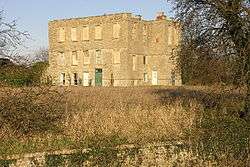Shireoaks Hall

Shireoaks Hall is a grade II* listed 17th-century country house in the hamlet of Shireoaks, 5 km north-west of Worksop, Nottinghamshire, UK.
The modestly sized house was originally built for Thomas Hewett, probably by John Smythson, between 1612 and 1617. It was remodelled around 1700 and further restored in 1812 and again after 1975. It is built of course square rubble with a slate roof and stands in a rectangular 16 hectare site, once open parkland with avenues of trees, fishponds and a deerpark, but now enclosed as farmland.[1][2]
History
The manor of Shireoak was given to the Priory of Worksop by Emma de Lovetot, the wife of its founder. After the Dissolution of the Monasteries by King Henry VIII, the land was granted to Robert and Hugh Thornhill, who sold it on to Thomas Hewet, a rich London merchant, who commissioned the building of the hall. On his death he left it to his son, Henry Hewet who left it to his son, Sir Thomas Hewet, who was Sheriff of Nottinghamshire for 1627. It was then inherited by the latter's grandson, another Sir Thomas Hewet, who was Surveyor-General of Woods in 1701 and 1714 and Surveyor of the King's Works from 1719 to 1726. He made extensive alterations and improvements to the house, and created several fine avenues, cascades, and water gardens. He also erected a banqueting house in the wood and formed or enlarged the deer-park.[3]
Sir Thomas left his estates to his godson, John Thornhaugh, of Osberton, who adopted the surname of Hewet. On the death of John Thornhaugh Hewet, Shireoaks and other properties passed to the Rev. John Hewet, Rector of Harthill, who built a chapel in the grounds. It was left by him to his relative John Wheatley. In 1812 Wheatley sold Shireoaks to Charles, Duke of Norfolk, who renovated it but whose descendants sold it in 1842, together with the Worksop manor estate, to the then Duke of Newcastle. In 1854 the latter Duke discovered a valuable coal seam beneath the land and eventually sold much of it to the Shireoaks Colliery Company and in 1863 built a church for the growing colliery village. [3]
In 1945 the hall, by now somewhat dilapidated, was sold to a local farmer. The house and the water gardens have been separately owned since the 1970s.
References
- ↑ "Shireoaks Hall, Shireoaks". British Listed Buildings. Retrieved 2012-11-19.
- ↑ "Nottinghamshire-Bassetlaw-Shireoaks" (PDF). Retrieved 2012-11-19.
- 1 2 "Nottinghamshire History: The Dukeries". Retrieved 2012-11-19.
Coordinates: 53°19′10″N 1°10′20″W / 53.3194°N 1.1722°W